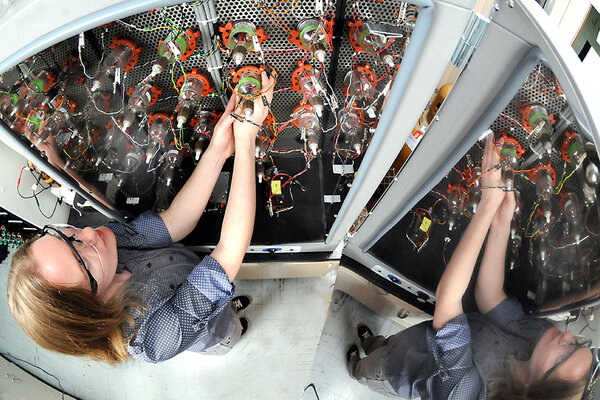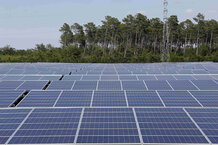How a new battery revolution will change your life
A new generation of super cells promises to reshape the future of energy.
CAMBRIDGE, MASS.; AND ARGONNE, ILL. — It’s probably safe to say that freshman chemistry rarely ranks among college students’ most memorable courses. An overcrowded lecture hall teems with 18-year-olds with chins propped on palms. Eyelids droop at the mere mention of Planck’s constant or Bohr’s model of hydrogen. Yawns abound.
So when Donald Sadoway began teaching introductory chemistry at the Massachusetts Institute of Technology in Cambridge in 1995, he wanted to liven things up. Sure, he still lectured on the properties of atomic arrangements in crystalline and amorphous solids, but he did it an unusual way: He peppered his presentations with chemistry jokes only an MIT undergrad would understand and wove literature and art into the rigid lines and squares of the periodic table.
A lifelong music lover, Dr. Sadoway paired each lecture with a relevant tune. He’d play Handel’s “Water Music” in a lecture on hydrogen bonding and Aretha Franklin’s “Chain of Fools” in a class on polymers. For DNA – that famous double-helix spiral – he’d play Hank Ballard’s version of “The Twist.”
Get it?
These days, Sadoway’s interests lie in another seemingly yawn-worthy subject: batteries. And he knows exactly what song to pair it with: John Lennon’s 1971 protest anthem “Power to the People.”
“I view the whole battery enterprise as very socially conscious,” says Sadoway, who has started his own battery company with the hope of changing the world’s energy future. “It would represent a major step in bringing electricity to those who don’t have reliable access to electricity now. And for those of us that do have reliable access, it would democratize the generation of electricity.”
It’s a dramatic endorsement for a technology most people think about only when their smartphone goes dark or their smoke alarm beeps incessantly. But Sadoway isn’t alone in trumpeting energy storage as a missing link to a cleaner, more efficient, and more equitable energy future.
Scientists and engineers have long believed in the promise of batteries to change the world. Now – finally – energy storage is beginning to live up to the hype. Advanced batteries are moving out of the lab and into “gigafactories.” They’re scaling up from smartphones and into smartgrids. They’re moving out of niche markets and creeping into the mainstream, signaling a tipping point for forward-looking technologies such as electric cars and rooftop solar panels.
The ubiquitous battery has already come a long way, of course. It is why we can carry more computing power in our pocket than what it took to put a man on the moon. It is why we text, take selfies, and tap on our phones on the bus or at the dinner table. The battery – specifically today’s lithium-ion battery – enables tweets from the front lines of war and police videos that stir protests. For better or worse, batteries make possible our mobile-first lifestyles, our screen culture, our increasingly globalized and hyperconnected world. Across the planet, billions pore over glowing screens, totally untethered and free to roam as they please.
Still, as impressive as all this is, it may be trivial compared with what comes next. Having already enabled a communications revolution, the battery is now poised to transform just about everything else – how we keep the lights on, travel from Point A to Point B, and spread power to those without it.
The wireless age is expanding to include not just our phones, tablets, and laptops, but also our cars, homes, and even whole communities. In emerging economies, rural communities are leapfrogging the wires and wooden poles that spread power across the West. Instead, some in Africa and Asia are seeing their first lightbulbs illuminated by the power of sunlight stored in batteries.
Today, energy storage is a $33 billion global industry that generates nearly 100 gigawatt-hours of electricity per year, according to Boston-based Lux Research. By the end of the decade, it is expected to be worth more than $50 billion and generate 160 GWh. That’s still just the equivalent of a AAAA battery in the sprawling energy industry, but it’s enough to attract the attention of major companies that might not otherwise be interested in a decidedly pedestrian technology. Even utilities, which have long viewed batteries and the alternative forms of energy they support as a threat, are learning to embrace the technologies as “enabling” rather than “disruptive.”
“It’s going to take a couple of decades, but the revolution is starting to happen now,” says Cosmin Laslau, a batteries analyst at Lux.
Done well, the revolution would mean energy used more wisely, more widely, and more cleanly. Today’s battery breakthroughs come as the world looks to expand modern energy access to the billion or so people without it, while also cutting back on fuels that warm the planet. Those simultaneous challenges appear less overwhelming with incrementally better answers to a centuries-old quandary: how to make power portable.
To be sure, the battery still has a long way to go before the nightly recharge completely replaces the weekly trip to the gas station. One need only ask the pilots of the Solar Impulse 2 about the shortcomings of today’s batteries. The solar-powered aircraft, which made the first attempt to fly around the world without consuming a drop of fuel, was grounded earlier this year after frying its batteries over the Pacific Ocean.
A battery-powered, electrified world comes with its own risks, too. Namely, what happens to the centralized electric grid, which took decades and billions of dollars to build, as more and more people become “prosumers,” generating and consuming their own energy on-site?
No one knows which – if any – battery technology will ultimately dominate, but one thing remains clear: The future of energy is in how we store it.
“So, ‘Power to the People,’ ” Sadoway reiterates. “Of course, they were referring to political power, but it’s a pretty good metaphor in this case.”
• • •
The battery’s rising influence is a product of its falling price. Like the solar panels they aim to bolster, batteries must compete with well-
entrenched mainstream fuels and the piston engines, power plant turbines, and other infrastructure associated with them. Also, like those of solar panels, battery costs have followed a dramatic downward curve over recent years.
Between 2007 and 2014, electric car battery costs dropped by more than half – from more than $1,000 per kilowatt-hour to around $410 per kWh, according to a study published earlier this year in the journal Nature Climate Change. It’s still not cheap enough to put an electric car in every garage, but it’s enough to carve out a niche market that gives a new technology the foundation from which to spread through suburbs and urban motor pools. And that trend should continue as manufacturers scale up production, tweak financing, and find other efficiencies: By 2025, the cost of batteries in electric vehicles will drop to as low as $172 per kWh, according to Lux.
“One of the remarkable things, looking back historically, is that for basically a century it was all about the internal combustion engine,” Dr. Laslau says. “We’re taking fuels and we’re blowing them up inside of cylinders. We’re now at a point where the alternative is here, and it’s staying here.”
Tech giant Google has a secretive team building better batteries, according to a report in The Wall Street Journal. Analysts speculate that Apple is doing the same, based on the company’s job postings. Nearly every major automaker has an electric vehicle for sale and many – notably Toyota and General Motors – are investing millions in designing new batteries to power them. It’s a veritable moon race to see who can build the first affordable electric vehicle to drive 200 miles on a single charge. Many analysts believe hitting that mark would dramatically accelerate a global transition from fossil fuels to electricity as the energy of choice for the automotive world.
Nor are Americans the only ones with their eyes on the battery’s future. Panasonic in Japan and Samsung in South Korea are two multinational companies that have long dominated the lithium-ion field. China’s lithium-ion battery market is expected to expand 400 percent by 2017, according to research firm China Chemicals Market. Chinese firms are pouring hundreds of millions of dollars into US battery companies, hoping for new technologies to meet the ballooning demand. Germany, which is attempting perhaps the most dramatic energy transition across the globe, is seen as a key early market for emerging home battery technologies. BMZ, based in Karlstein, Germany, is building Europe’s largest rechargeable battery production facility.
In the United States, Tesla Motors is among those pushing the battery era the hardest. The California-based company has spent the past 12 years doing to electric vehicles what Apple did to early MP3 players – making them cool. It already has a battery-powered car that goes 200 miles on a single charge – the Model S – but its $70,000-plus price tag keeps it beyond the reach of most drivers.
Tesla believes it can bring its car to the masses without any radical new breakthroughs in the lithium-ion chemistry that powers most of today’s gadgets and electric vehicles. Last February the company unveiled a $5 billion plan for a battery “gigafactory” that it says will be able to supply half a million cars when it opens. Scale, in other words, could be the secret to an inexpensive, 200-mile-range electric vehicle.
But Tesla’s battery ambitions go beyond just cars. Elon Musk, the company’s dynamic chief executive, envisions a future in which batteries – paired with solar panels – power homes, businesses, and whole communities. By providing on-site storage for backup power, the setup would directly address renewable energy’s Achilles’ heel – that the sun doesn’t always shine and the wind doesn’t always blow. It would shift a reliance on fossil fuels to a reliance on a power plant that is 4.5 billion years old and 93 million miles away.
“We have this handy fusion reactor in the sky called the sun,” Mr. Musk mused in April at the launch of Tesla’s suite of energy-storage devices. “You don’t have to do anything. It just works, shows up every day, and produces ridiculous amounts of power.”
Most analysts expect the Powerwall, Tesla’s battery for homes, to appeal to only a small number of people, at least until the price and associated costs drop further. With a capacity of between only 7 and 10 kWh, and a price tag ranging from $3,000 to $3,500, the economics just don’t make sense for most consumers across the US. But the larger-sized Powerpacks are already proving attractive to businesses and utilities, which have more of a financial incentive to avoid the violent fluctuations in energy supply and demand. And when the gigafactory comes on line in 2017, Tesla hopes the economies of scale will drive prices down to a point where home batteries entice a lot of people.
For Musk, “a lot of people” means just about everyone. At April’s launch, Musk calculated it would take roughly 2 billion Powerpacks to electrify the entire world. That sounds like a lot, but, as Musk noted, it’s on par with the number of cars and trucks on the road.
“This is actually within the power of humanity to do,” he said. “We have done things like this before.”
• • •
When the National Academy of Engineering cast about for something to anoint as the greatest engineering achievement of the 20th century, it didn’t settle on the automobile. Or the airplane. Or even anything from the gee-whiz world of electronics.
It chose the pedestrian electrical grid.
That perhaps shouldn’t be surprising. The electrical grid is the aorta of modern civilization – the channel that brings power and light to virtually every family and factory in the developed world. But it does have a fundamental flaw.
“The grid is the biggest supply chain on the planet – and it has zero inventory,” says Sadoway, perched on a stool in a lab back at MIT. “The electricity that powers the lights in this building was generated just moments ago.”
Power, in other words, is tailor-made for the moment you need it. Grid operators are constantly ramping generators up or down to ensure supply meets demand. Entire power plants remain idle for much of the year, called into service only when people reach for their thermostats – during a heat wave or a polar vortex, for example. If supply and demand fall out of sync, “bad things start to happen,” Sadoway says. It’s a delicate balancing act of mammoth proportions.
No wonder, then, that batteries represent a potential paladin for the electrical grid. Grid-scale batteries would give utilities an emissions-free, easily dispatchable way to store energy that can be summoned during moments of surging demand. To some, batteries could do to electricity what refrigeration did to our food supply and storage tanks to our access to water.
“It doesn’t have to be raining when you’re taking a shower because we’ve got cisterns,” Sadoway says. “If we had something analogous to that for electricity, it would make the supply chain so much more stable.”
Sadoway is skeptical that today’s lithium-ion chemistry will do the trick. Inspired by aluminum smelting, he and his students have developed an all-liquid-metal battery that packs a bigger punch than lithium-ion and – most important – does so over a longer life span. The battery’s unique floating chemistry doesn’t require internal structures that degrade over time, which means it can discharge and recharge tens of thousands of times before wearing out. His team also uses earth-abundant minerals such as magnesium and antimony instead of scarcer metals such as lithium that pervade today’s batteries.
“If you want to make it dirt-cheap, make it out of dirt,” Sadoway is fond of saying, “and preferably dirt from your own backyard, because then you know you have a secure supply chain!”
In 2010, Sadoway and David Bradwell, one of his students, cofounded a company called Ambri with the intent of commercializing the technology. Five years later, it has 50 employees, more than $50 million in financing, and a prototype manufacturing plant tucked away in an industrial park in Marlborough, Mass. Count Microsoft founder Bill Gates among its investors. The tech magnate took one of Sadoway’s courses anonymously online, and reached out soon thereafter to learn more about the promising technology.
Later this year, Ambri is launching two pilot projects, and it eventually hopes to sell its modular battery packs to utilities, hospitals, and other groups that could benefit from large amounts of on-demand electricity.
• • •
Halfway across the country from MIT, in the woods southwest of Chicago, there is something like a college campus where all the students have advanced degrees and work on the great challenges of our time.
Argonne National Laboratory is a staple of postwar American science. Nuclear power has its origins here. Argonne scientists analyzed lunar rocks from humanity’s first moon landing. In 1957, a physicist stuck his arm in an ultrasonic scanner at Argonne, and – voilà – the world’s first ultrasound image of the human body.
Today, the sprawling 1,500-acre complex still feels like an Atomic Age temple to science, but the work inside is geared firmly toward today’s challenges. Those who wander Argonne’s labyrinthine corridors talk coolly but intently about the need to wean ourselves off the carbon-heavy fuels that made modern civilization possible. They worry about dependence on oil from unstable foreign governments. They worry about smog-choked skylines and emissions that trap heat in the atmosphere.
But instead of inventing a better solar panel or wind turbine, one team at Argonne is looking for energy solutions in better batteries.
The Argonne-led Joint Center for Energy Storage Research (JCESR) is looking for the next big breakthrough in energy storage – a technology that would store at least five times as much energy as today’s batteries at one-fifth the cost. In late 2012, it received a $120 million grant from the Department of Energy to make it happen within five years. It’s a timeline that even Jeff Chamberlain, who leads JCESR’s partnerships with industry, admits is at the limit of theoretical possibility. But if the center meets its mark, he says, it would do to energy what social media has done to information and communication.
“The end result is that, for good or for bad, individuals have a voice in a way that we never did in history,” Dr. Chamberlain says, echoing Sadoway’s view of batteries as democratizing. “I think that kind of thing can happen with energy, and the battery is a huge enabler.”
To an outsider, JCESR (pronounced “jay-Caesar”) feels like a heady test kitchen. PhD-enabled chefs cull ingredients from the periodic table to design recipes steeped in the fundamental laws of the universe. Take a pinch of manganese, add a dash of nickel, stir in cobalt, bake at 400 degrees for 30 minutes – and hope what comes out will help change the future of the world.
A typical day here is like “studying for a physics test,” says Jason Croy, who oversees scientists testing small battery prototypes at Argonne. “You’re thinking about things you don’t understand – that nobody understands.”
Even so, the basic science of batteries is simple. There’s an anode on one end, a cathode on the other, and a chemical electrolyte in between. When a battery is used, the anode releases positively charged atoms called ions that travel across the electrolyte to the cathode. The cathode then attracts negatively charged particles called electrons that flow through an external circuit, bringing to life whatever device is connected. When a battery is plugged in to recharge, the ions flow back to the anode, converting electric energy back into stored chemical energy.
“The science of batteries is really fundamental science,” Dr. Croy says. “It’s physics – basic problems at the atomic and subatomic level.”
Italian scientist Alessandro Volta is widely considered the field’s founding father, having developed a primitive battery using metal discs and brine-soaked cardboard back in 1800. The first lead-acid battery came 60 years later and still serves as the energy-storage device in most cars. Zinc-carbon batteries powered early hand-held devices in the first half of the 20th century. The rise of alkaline batteries paved the way for better-performing flashlights, remote controls, and portable electronics in the 1960s. Then came the high-density, lightweight lithium-ion battery in the 1980s, which enabled today’s mobile revolution.
Now JCESR is looking beyond lithium ion to find the next breakthrough in battery science – in different ions, new chemical reactions, and unique battery structures. The other half of JCESR’s mission is to streamline the cumbersome process of developing a new battery technology, testing a prototype, scaling it up in the lab, replicating it on the factory line, and, finally, safely installing it in the car you drive.
For Chamberlain, a self-professed “Detroit kid” who witnessed firsthand the decline of US manufacturing, there’s a personal stake in all this.
“My grandfather, my uncle, were lifelong Ford employees ... and we’ve watched Detroit become decimated,” he says. “It’s difficult to say whether that could have been prevented, but there are certain technological opportunities to bring innovation and manufacturing back onto our soil.”
• • •
Thirty-one years ago, Motorola released the world’s first commercial cellular phone – an unwieldy plastic brick weighing two pounds, with a price tag of $3,995. It won the favor of wealthy Wall Street types (think Gordon Gekko), but it was impractical for a general public that made do with landlines and, in some cases, car phones. At the time, no one could be certain portable phones would ever make sense for the average consumer.
Today, the battery finds itself at a similar juncture. True, the battery has been around for a long time and already powers everything from laptops to cordless screw guns. But the question is whether the next generation of batteries will be cheap enough and have enough storage to make the electric car and home energy systems as omnipresent as the iPhone.
Energy, of course, is vastly different from telecommunications, and it will likely take much longer to overhaul the world’s vast network of pipelines, power plants, and transmission lines. But a transition has already begun to some sort of new Eveready future, judging from the amount of money and intellectual power flowing into next-generation batteries.
And it is the next generation of thinkers fathoming the unfathomable that keeps Sadoway mixing exotic battery brews for his company in Marlborough and teaching in classrooms in Cambridge.
“You’ve got bright people who are intellectually fearless, and we give them impossible problems and they work on them with enthusiasm,” he says of his students. “It stands to reason [that we should] harness that unbridled enthusiasm and intellectual horsepower.”



























































